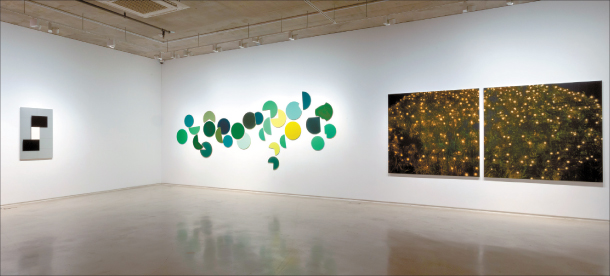Pibi exhibits interpretations of relationships

Pibi Gallery’s new exhibit “PIBI_LINK” features works by eight artists who drew inspiration for the ways relationships are formed. [PIBI GALLERY]
A fairly young gallery, Pibi opened its doors in 2016 with a solo exhibition by artist Lee Jeong-bae and has since then attracted art lovers with its unique curation of art in the quiet corner of the Samcheong-dong neighborhood.
In 2018, the gallery held its first “PIBI_LINK,” featuring artists Chung Seung-il and Kim Tae-woo who showed their different interpretations of the gallery’s architectural structure.
This time for the second edition, the roster is richer - with Kim Young-jun, Kim Hee-young, An Gyung-su, Lee Kyo-jun, Lee Eun-sun, Lee Jeong-bae, Lee Jong-geon and Jung Seung-hye.
There seems to be no apparent similarity between the eight artists except for the fact that they were exhibited by the gallery over the last three years and all the works are new. Even the medium spans from paintings to installations and video, all different in their own colors. Yet the “link” that ties them together exists in the stories of how the works were created - how people, objects and space influence and change one another according to the relationships they form.
For instance, Lee Jeong-bae’s installation “Greens” was inspired by a picture he received from a friend of a field made by a center pivot irrigation system in the Saudi Arabian dessert. He saw the circular shapes and was inspired by how nature was shaped by humans, or the creation of man-made nature.
“In the cityscape, nature is interrupted by man-made figures,” he said. “Just like the way mountains are blocked by buildings, straight lines work as a way of oppression that influences and changes the landscape. We pass them by without thinking about it, but I wanted to show that through the installation.” Similarly, artist Lee Jong-geon wanted to express how the individual aspects of architecture seem completely different when they’re taken out of their original context. The plywood installations symbolize the pillars and walls of architecture and how they’re complete only when they form a relationship with others they are similar to. Lee Eun-sun’s vinyl installation “Core” is taken from children’s paper necklaces and how people form relationships from when they’re young, while An’s “Brightness” shows how light changes the scenery throughout the day and how that change ultimately affects the way we see our surroundings.
“All the works were created quite experimental for every artist,” said director Kim Hae-kyung. “We were actually a bit worried about how the works would fit in with one another. But when we installed them, it was as if they had been planned together from the beginning. They’re different, but that difference forms a unique harmony.”
BY YOON SO-YEON [yoon.soyeon@joongang.co.kr]










with the Korea JoongAng Daily
To write comments, please log in to one of the accounts.
Standards Board Policy (0/250자)